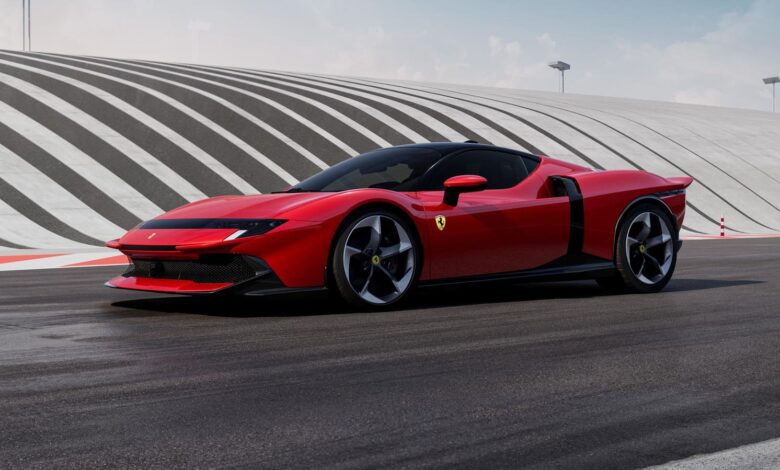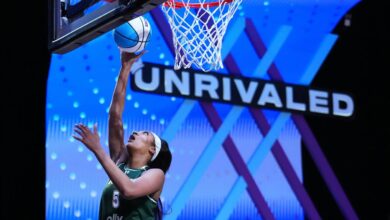Ferrari Reveals The New V8 Hybrid 849 Testarossa: 1035 Horsepower

📝 usncan Note: Ferrari Reveals The New V8 Hybrid 849 Testarossa: 1035 Horsepower
Disclaimer: This content has been prepared based on currently trending topics to increase your awareness.
Evolving out of and succeeding the SF90 Stradale is the Ferrari 849 Testarossa, a mid-engine hybrid supercar with an 818-horsepower twin-turbo V8 mounted midship, complimented by three electric motors, two placed in the nose powering the front wheels, and one at the rear streaming electric torque to the rear wheels, a logical and proven layout defined by the SF90 Stradale.
Ferrari
Evolving out of and succeeding the SF90 Stradale is the Ferrari 849 Testarossa, a mid-engine hybrid supercar with an 818-horsepower twin-turbo V8 mounted midship, complimented by three electric motors, two placed in the nose powering the front wheels, and one at the rear streaming electric torque to the rear wheels, a logical and proven layout defined by the SF90 Stradale.
All in, the V8 and motors can deliver a maximum of 1035 horsepower, which is considerable in a car constructed of carbon-fiber, titanium and other lightweight materials and weighing 3461 lbs.
Ferrari
All in, the V8 and motors can deliver a maximum of 1035 horsepower, which is considerable in a car constructed of carbon-fiber, titanium and other lightweight materials and weighing 3461 lbs.
The rear adopts a twin-tail architecture inspired by the 512 S, with two wing sections (called twin tail) that exploit the high-energy flow that laps the top of the muscular rear wheelarches to generate 10% of the downforce at the rear.
Ferrari
With the expected suite of computer-controlled traction and stability control systems, Testarossa can reach 60 mph in about 2.3 seconds, and 124 mph (200 kph) in an astounding 6.35 seconds, which means it will likely cover the classic American measurable of a standing quarter-mile sprint in the 9-second range, likely the low nines. That’s what you call relentless acceleration, and it’s why people stand in line to buy the mid-engine V8 Ferraris.
Testarossa’s interior blends the forms and functions of a classic Berlinetta with the cockpit sensibilities of a single-seater. This photo shows just how the driver is enveloped by central console and door panels. The F80-inspired gate is integrated in a floating position in the sail on the steering wheel side.
Ferrari
Ferrari has adopted materials and fabrication methods from its Formula One and Le Mans experience to reduce weight, and 849 Testarossa has the best power-to-weight ratio ever for what Ferrari calls a “range model” (meaning a series production car and not an ultra-high-performance variant produced in limited numbers). The significant performance gains compared to the outgoing SF90 Stradale have not resulted in any weight gain.
Note that gearbox control is on the “cockpit” side of the center panel, just a short reach from the right-side of the steering wheel. The new steering wheel, equipped with mechanical buttons.
Ferrari
Testarossa’s V8 is related to the V8 used in many Ferraris, but it received a radical reimagination, with completely revised components, including the all-new and very large turbocharger, unique cylinder heads, engine block, exhaust manifolds, intake plenums, titanium fasteners, valve train system, and fuel rail. So, it’s the “same” engine, but completely new.
The squarer front bumper has integrated bumperettes that help increase the airflow to the front air intakes and generate vorticity useful for extracting the flow from the wheel arch. Splitter incorporates a flick, inspired by the SF90 XX Stradale, responsible for 10% of the front downforce.
Ferrari
Early on, the dull chamber music of the Ferrari 296’s wide-angle V6 gas-electric hybrid powertrain was roundly criticized. Most people believe a Ferrari is both a weapon of speed and a musical instrument.
Note clean upper dash surface, and its relatively low height compared to position of driver’s head and shoulder height. Also, flat-bottom steering wheel to increase thigh room.
Ferrari
To ensure no such criticism is leveled against Testarossa, considerable engineering effort has been invested in the Maranello Orchestra. Ferrari’s press staff argues strongly that the Testarossa will sing that familiar Italian aria, with a particularly exuberant flourish near the 8300-rpm redline. Following long-established Ferrari practice, Testarossa has a “flat” crankshaft, a design that leads to easy high revs. No motorboat sounds here, no industrial vacuum cleaner sounds.
The active rear spoiler, derived from that of the SF90 Stradale and the 296 GTB, is integrated into the bodywork and actioned by a kinematic solution that is 2 kg lighter. It can switch between Low Drag and High Downforce configurations in less than a second. In High Downforce configuration, it helps to generate up to 100 kg of downforce at 250 km/h, working in synergy with the passive elements of the tail. The rear underbody adopts a multi-level diffuser with a suspended lower element and vertical fences that allow the wheel wake to be isolated.
Ferrari
In addition to the latest generation brake-by-wire system, Testarossa is equipped with Ferrari’s ABS Evo controller, which improves braking precision and consistency in all conditions.
Engine Start button on lower left of wheel. eManettino is red control on lower right, allowing selection of drive modes. In eDrive mode, the car can travel up to 15 miles (25 km) in purely electric drive thanks to the 7.45 kWh lithium-ion battery installed low in the chassis to ensure a low center of gravity and optimal weight balance.
Ferrari
Testarossa’s interior blends the forms and functions of a classic Berlinetta with the cockpit sensibilities of a single-seater. The F80-inspired gate is integrated in a floating position in the sail on the steering wheel side.
The battery and electric motor management strategies are calibrated according to the four electric driving modes that can be selected via the eManettino — eDrive, Hybrid, Performance and Qualify — optimizing performance in all conditions.
Ferrari
Testarossa’s central tunnel layout distributes the secondary controls in a rational and minimalist way. Central sail theme is picked up on the door panels where it houses a woofer with an aluminum grille. Seats are available in two versions. Comfort, or a carbon-fiber racing seat, with aggressive side bolsters.
Testarossa Spider. Connectivity is guaranteed by compatibility with Apple CarPlay® and Android Auto®, while wireless charging for smartphones is integrated into the central tunnel. The car is also equipped with the MyFerrari Connect system, which allows the vehicle to be monitored remotely via a dedicated App.
Ferrari
Testarossa’s steering wheel integrates digital and analog functions. Mechanical controls already seen on the F80 have been carried over, including the Engine Start button, while the digital cluster allows the rapid reconfiguration of the electric driving modes via the eManettino.
The increase in engine power was achieved without any significant weight penalty thanks to machining inspired by racing engines, lightening of the camshafts and the adoption of titanium screws, improving the weight/power ratio by almost 10% compared to the SF90 Stradale.
Ferrari
Connectivity is guaranteed by compatibility with Apple CarPlay® and Android Auto®, while wireless charging for smartphones is integrated into the central tunnel. The car is also equipped with the MyFerrari Connect system, which allows the vehicle to be monitored remotely via a dedicated App.
The twin-turbo V8 produces 818 horsepower at 7500 rpm and 621 lb.-ft. of torque at 6500 rpm. The electric motors collectively produce the equivalent of about 217 horsepower.
Ferrari
The battery and electric motor management strategies are calibrated according to the four electric driving modes that can be selected via the eManettino — eDrive, Hybrid, Performance and Qualify — optimizing performance in all conditions.
Ferrari Testarossa Spider.
Ferrari
In eDrive mode, the car can travel up to 15 miles (25 km) in purely electric drive thanks to the 7.45 kWh lithium-ion battery installed low in the chassis to ensure a low center of gravity and optimal weight balance. Testarossa’s eDrive is clearly meant to transit European and UK net zero urban areas, allowing the owner to drive into, say the City of London, then switch to eDrive for the last few miles to the glass tower.
Ferrari Testarossa Spider
Ferrari
Perhaps not a daily driver, but Testarossa has a complete suite of driver assistance systems for just such transit in congested urban areas, or when using open highway. Systems include Adaptive Cruise Control with Stop & Go, Automatic Emergency Braking with Cyclist Detection, Blind Spot Detection, Lane Departure Warning, Lane Keeping Assist, Automatic High Beam, Traffic Sign Recognition, Surround View, Rear Cross Traffic Alert and driver fatigue monitoring.
Assetto Fiorano has a track focus and is about 66 pounds. Specific components include the new lightweight tubular seat that saves around 39 pounds, and 20-inch carbon fiber wheels that reduce unsprung mass and improve responsiveness when accelerating and braking. Assetto’s front has more aggressive aerodynamic tricks. Vehicle dynamics have been optimized with stiffer, single-rate Multimatic shock absorbers, springs lightened by 35% and a roll gradient reduced by 10%, improving body control and aerodynamic efficiency.
Ferrari
For those focused on track time rather than pleasure drives in the country, Ferrari offers the Assetto Fiorano specification, which is about 66 pounds lighter thanks to extensive use of composite materials such as carbon fiber and titanium. Specific components include the new lightweight tubular seat upholstered in black Alcantara©, which saves around 39 pounds compared to the standard seats, and 20-inch carbon fiber wheels that reduce unsprung mass and improve responsiveness when accelerating and braking. Assetto’s front has more aggressive aerodynamic tricks. Vehicle dynamics have been optimized with stiffer, single-rate Multimatic shock absorbers, springs lightened by 35% and a roll gradient reduced by 10%, improving body control and aerodynamic efficiency.
Three cars of the Ecurie Nationale Belge in the pit lane before the 24 Hours of Le Mans Race, June 1957. Car no. 28 is a Ferrari 500TR which was driven by Lucien Bianchi and Georges Harris to a class win and 7th overall. (Photo by Klemantaski Collection/Getty Images)
Getty Images
Californian Phil Hill drives the Ferrari 250 Testa Rossa 59 at the 24 Hours of Le Mans, Le Mans, 21 June 1959. (Photo by Bernard Cahier/Getty Images) Phil Hill was the first American to win a world driver’s championship, in 1961 at the wheel of a Ferrari.
Getty Images
Testa Rossa (red head) was born as a nickname for a car that had red crackle finish paint on its cam covers instead of the expected black paint, the 500 TR of 1956. Several Ferrari sport-racing cars carried the TR name forward. In 1984 Ferrari introduced the Testarossa road car, a Berlinetta known for its side strake and of course for its flat twelve engine. For 2026, we now have the 849 Testarossa.




